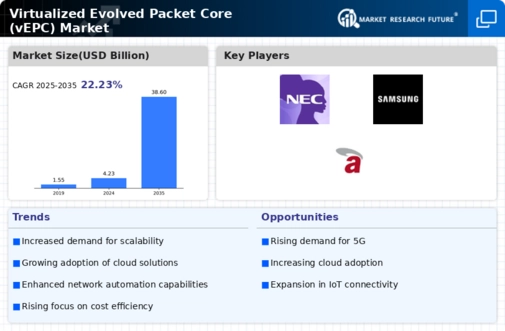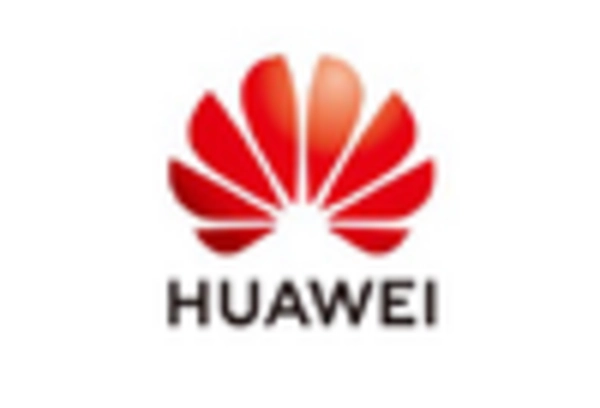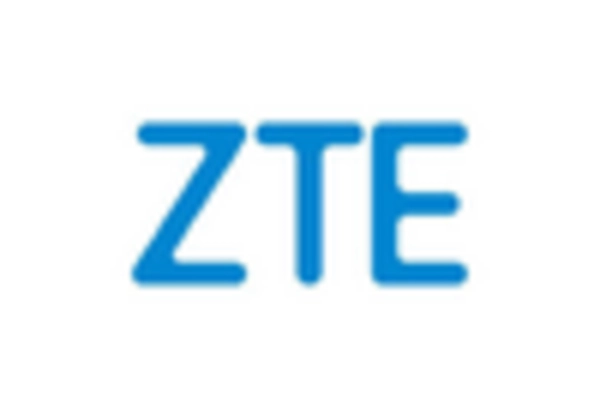-
Executive Summary
-
Market
-
Introduction
-
Definition 16
-
Scope Of The Study 16
-
List Of Assumptions 17
-
Market Structure 17
-
Market Insights
-
Research Methodology
-
Research Process
-
Primary Research 23
-
Secondary Research 24
-
Market Size Estimation 24
-
Forecast Model 25
-
Market Dynamics
-
Introduction
- Drivers Impact Analysis 29
-
Drivers 28
-
Need To Increase The Capacity, Coverage, And Minimization Of Capital And Operational
-
Expenditure 28
-
Growing Demand For LTE Communication Technology, And Smartphone Users Leading To
-
Virtualization Of EPC 28
-
Challenges 29
- Disinclination For Telecom Vendors In The Transition
-
From Traditional Infrastructure To Virtualized Infrastructure 29
-
Opportunities 30
- Advancement
-
In Technologies Such As 5G, IoT, And M2M 30
-
Market Factor Analysis
-
Value Chain Analysis 32
- Porter’s
- Threat Of New Entrants 34
- Bargaining Power Of Suppliers 34
- Bargaining
- Threat Of Substitutes 34
- Intensity Of Rivalry 34
-
Five Forces Model 32
-
Power Of Buyers 34
-
Global Virtualized Evolved
-
Packet Core Market, By Component
-
Overview 36
- Solution 36
- Services 38
-
Server (HSS) 36
-
Serving Gateway (S-GW) 37
-
Functions (PCRF) 37
-
Global Virtualized
-
Evolved Packet Core Market, By Deployment
-
Overview 41
- On-Premise 41
- On-Cloud 41
-
Global Virtualized Evolved Packet Core Market,
-
By Use Case
-
Overview 44
-
Broadband Wireless Access (BWA) 44
-
LTE & VoLTE 44
-
IoT & M2M 44
-
MNO & MVNO 44
-
Global Virtualized Evolved Packet Core Market,
-
By End-User
-
Overview 47
-
Telecom Operator 47
-
Enterprises 47
-
Virtualized Evolved Packet Core Market, By Region
-
Introduction
-
North America 51
-
US 55
-
Canada 57
-
Mexico 58
-
Europe 60
-
Germany 64
-
UK 65
-
France 67
-
Rest Of Europe 68
-
Asia-Pacific 71
- China 75
- Japan 77
- India 78
- Rest Of Asia-Pacific 80
-
Rest Of The World 82
- Middle East
-
& Africa 86
-
Latin America 87
-
Competitive Landscape
-
Competitive Landscape 91
-
Company Profile
-
Nokia Corporation 94
- Company Overview 94
- Financial
- Key Developments 95
- SWOT Analysis 95
- Key Strategy
- Company Overview 97
- Financial Performance 97
- Products/Services/Solutions
- SWOT Analysis 99
- Key Strategies 99
-
Performance 94
-
Products/Services/Solutions Offerings 95
-
Cisco System Inc., 97
-
Offerings 98
-
Key Developments 98
-
Huawei Technologies Co.
- Financial Performance 100
- Products/Services/Solutions Offerings 101
- Key Developments
- Key Strategies 102
-
Ltd 100
-
Company Overview 100
-
SWOT Analysis 102
-
NEC Corporation 103
- Company Overview 103
- Financial
- Key Developments 104
- SWOT Analysis 105
- Key Strategy
- Financial Performance 106
- Products/Services/Solutions Offerings 107
- Key Developments
- Key Strategies 108
-
Performance 103
-
Products/Services/Solutions Offerings 104
-
Ericsson 106
-
Company Overview 106
-
SWOT Analysis 108
-
Samsung Electronics 109
- Company Overview 109
- Financial
- Key Developments 110
- SWOT Analysis 111
- Key Strategy
- Company Overview 112
- Financial Performance 112
- Products/Services/Solutions
- SWOT Analysis 114
- Key Strategy 114
-
Performance 109
-
Products/Services/Solutions Offerings 110
-
ZTE Corporation 112
-
Offerings 113
-
Key Developments 113
-
Mitel Networks Corporation ( Mavenir) 115
- Company
- Products/Services/Solutions Offerings 116
- Key Developments 116
- SWOT Analysis
- Company Overview 118
- Products/Services/Solutions Offerings 118
- Key Developments
- Company Overview 120
- Products/Services/Solutions Offerings 120
- Key Developments
-
Overview 115
-
Financial Performance 115
-
Key Strategy 117
-
Affirmed Networks 118
-
Key Strategy 119
-
Athonet S.R.L 120
-
-
List Of Tables
-
MARKET
-
SYNOPSIS 14
-
TABLE
-
LIST OF ASSUMPTIONS 17
-
GLOBAL VIRTUALIZED EVOLVED PACKET CORE MARKET, BY COMPONENT,
-
GLOBAL VIRTUALIZED EVOLVED PACKET CORE MARKET, BY SERVICES,
-
GLOBAL VIRTUALIZED EVOLVED PACKET CORE MARKET, BY DEPLOYMENT,
-
GLOBAL VIRTUALIZED EVOLVED PACKET CORE MARKET, BY USE CASE,
-
GLOBAL VIRTUALIZED EVOLVED PACKET CORE MARKET, BY END-USER,
-
GLOBAL VIRTUALIZED EVOLVED PACKET CORE MARKET, BY REGION, 2020-2027
-
(USD MILLION) 50
-
TABLE
-
NORTH AMERICA: VIRTUALIZED EVOLVED PACKET CORE MARKET, BY COUNTRY, 2020-2027 (USD
-
MILLION) 52
-
TABLE
-
NORTH AMERICA: VIRTUALIZED EVOLVED PACKET CORE MARKET, BY COMPONENT, 2020-2027
-
(USD MILLION) 52
-
TABLE
-
NORTH AMERICA: VIRTUALIZED EVOLVED PACKET CORE MARKET, BY DEPLOYMENT , 2020-2027
-
(USD MILLION) 53
-
TABLE
-
NORTH AMERICA: VIRTUALIZED EVOLVED PACKET CORE MARKET, BY USE CASE , 2020-2027
-
(USD MILLION) 54
-
TABLE
-
NORTH AMERICA: VIRTUALIZED EVOLVED PACKET CORE MARKET, BY END-USER, 2020-2027
-
(USD MILLION) 55
-
TABLE
-
US: VIRTUALIZED EVOLVED PACKET CORE MARKET, BY COMPONENT, 2020-2027 (USD MILLION)
-
TABLE
-
US : VIRTUALIZED EVOLVED PACKET CORE MARKET, BY DEPLOYMENT, 2020-2027 (USD MILLION)
-
TABLE
-
US: VIRTUALIZED EVOLVED PACKET CORE MARKET, BY USE CASE, 2020-2027 (USD MILLION)
-
TABLE
-
US: VIRTUALIZED EVOLVED PACKET CORE MARKET, BY END-USER, 2020-2027 (USD MILLION)
-
TABLE
-
CANADA: VIRTUALIZED EVOLVED PACKET CORE MARKET, BY COMPONENT, 2020-2027 (USD
-
MILLION) 57
-
TABLE
-
CANADA: VIRTUALIZED EVOLVED PACKET CORE MARKET, BY DEPLOYMENT , 2020-2027 (USD
-
MILLION) 57
-
TABLE
-
CANADA: VIRTUALIZED EVOLVED PACKET CORE MARKET, BY USE CASE 2020-2027 (USD MILLION)
-
TABLE
-
CANADA: VIRTUALIZED EVOLVED PACKET CORE MARKET, BY END-USER, 2020-2027 (USD MILLION)
-
TABLE
-
MEXICO: VIRTUALIZED EVOLVED PACKET CORE MARKET, BY COMPONENT, 2020-2027 (USD
-
MILLION) 58
-
TABLE
-
MEXICO: VIRTUALIZED EVOLVED PACKET CORE MARKET, BY DEPLOYMENT, 2020-2027 (USD
-
MILLION) 58
-
TABLE
-
MEXICO: VIRTUALIZED EVOLVED PACKET CORE MARKET, BY USE CASE, 2020-2027 (USD MILLION)
-
TABLE
-
MEXICO: VIRTUALIZED EVOLVED PACKET CORE MARKET, BY END-USER 2020-2027 (USD MILLION)
-
TABLE
-
EUROPE VIRTUALIZED EVOLVED PACKET CORE MARKET, BY REGION, 2020-2027 (USD MILLION)
-
TABLE
-
EUROPE VIRTUALIZED EVOLVED PACKET CORE MARKET, BY COMPONENT, 2020-2027 (USD MILLION)
-
TABLE
-
EUROPE VIRTUALIZED EVOLVED PACKET CORE MARKET, BY DEPLOYMENT, 2020-2027 (USD
-
MILLION) 62
-
TABLE
-
EUROPE VIRTUALIZED EVOLVED PACKET CORE MARKET, BY USE CASE, 2020-2027 (USD MILLION)
-
TABLE
-
EUROPE VIRTUALIZED EVOLVED PACKET CORE MARKET, BY END-USER, 2020-2027 (USD MILLION)
-
TABLE
-
GERMANY: VIRTUALIZED EVOLVED PACKET CORE MARKET, BY COMPONENT, 2020-2027 (USD
-
MILLION) 64
-
TABLE
-
GERMANY: VIRTUALIZED EVOLVED PACKET CORE MARKET, BY DEPLOYMENT, 2020-2027 (USD
-
MILLION) 64
-
TABLE
-
GERMANY: VIRTUALIZED EVOLVED PACKET CORE MARKET, BY USE CASE, 2020-2027 (USD
-
MILLION) 65
-
TABLE
-
GERMANY: VIRTUALIZED EVOLVED PACKET CORE MARKET, BY END-USER, 2020-2027 (USD
-
MILLION) 65
-
TABLE
-
UK: VIRTUALIZED EVOLVED PACKET CORE MARKET, BY COMPONENT , 2020-2027 (USD MILLION)
-
TABLE
-
UK: VIRTUALIZED EVOLVED PACKET CORE MARKET, BY DEPLOYMENT, 2020-2027 (USD MILLION)
-
TABLE
-
UK: VIRTUALIZED EVOLVED PACKET CORE MARKET, BY USE CASE, 2020-2027 (USD MILLION)
-
TABLE
-
UK: VIRTUALIZED EVOLVED PACKET CORE MARKET, BY END-USER, 2020-2027 (USD MILLION)
-
TABLE
-
FRANCE : VIRTUALIZED EVOLVED PACKET CORE MARKET, BY COMPONENT, 2020-2027 (USD
-
MILLION) 67
-
TABLE
-
FRANCE: VIRTUALIZED EVOLVED PACKET CORE MARKET, BY DEPLOYMENT, 2020-2027 (USD
-
MILLION) 67
-
TABLE
-
FRANCE: VIRTUALIZED EVOLVED PACKET CORE MARKET, BY USE CASE, 2020-2027 (USD MILLION)
-
TABLE
-
FRANCE: VIRTUALIZED EVOLVED PACKET CORE MARKET, BY END-USER, 2020-2027 (USD MILLION)
-
TABLE
-
REST OF EUROPE : VIRTUALIZED EVOLVED PACKET CORE MARKET, BY COMPONENT, 2020-2027
-
(USD MILLION) 68
-
TABLE
-
REST OF EUROPE: VIRTUALIZED EVOLVED PACKET CORE MARKET, BY DEPLOYMENT, 2020-2027
-
(USD MILLION) 69
-
TABLE
-
REST OF EUROPE: VIRTUALIZED EVOLVED PACKET CORE MARKET, BY USE CASE, 2020-2027
-
(USD MILLION) 69
-
TABLE
-
REST OF EUROPE: VIRTUALIZED EVOLVED PACKET CORE MARKET, BY END-USER 2020-2027
-
(USD MILLION) 69
-
TABLE
-
ASIA-PACIFIC VIRTUALIZED EVOLVED PACKET CORE MARKET, BY REGION, 2020-2027 (USD
-
MILLION) 72
-
TABLE
-
ASIA-PACIFIC VIRTUALIZED EVOLVED PACKET CORE MARKET, BY COMPONENT, 2020-2027
-
(USD MILLION) 72
-
TABLE
-
ASIA-PACIFIC VIRTUALIZED EVOLVED PACKET CORE MARKET, BY DEPLOYMENT, 2020-2027
-
(USD MILLION) 73
-
TABLE
-
ASIA-PACIFIC VIRTUALIZED EVOLVED PACKET CORE MARKET, BY USE CASE, 2020-2027 (USD
-
MILLION) 74
-
TABLE
-
ASIA-PACIFIC VIRTUALIZED EVOLVED PACKET CORE MARKET, BY END-USER, 2020-2027 (USD
-
MILLION) 75
-
TABLE
-
CHINA : VIRTUALIZED EVOLVED PACKET CORE MARKET, BY COMPONENT, 2020-2027 (USD
-
MILLION) 75
-
TABLE
-
CHINA: VIRTUALIZED EVOLVED PACKET CORE MARKET, BY DEPLOYMENT, 2020-2027 (USD
-
MILLION) 76
-
TABLE
-
CHINA: VIRTUALIZED EVOLVED PACKET CORE MARKET, BY USE CASE, 2020-2027 (USD MILLION)
-
TABLE
-
CHINA: VIRTUALIZED EVOLVED PACKET CORE MARKET, BY END-USER, 2020-2027 (USD MILLION)
-
TABLE
-
JAPAN : VIRTUALIZED EVOLVED PACKET CORE MARKET, BY COMPONENT, 2020-2027 (USD
-
MILLION) 77
-
TABLE
-
JAPAN: VIRTUALIZED EVOLVED PACKET CORE MARKET, BY DEPLOYMENT, 2020-2027 (USD
-
MILLION) 77
-
TABLE
-
JAPAN: VIRTUALIZED EVOLVED PACKET CORE MARKET, BY USE CASE, 2020-2027 (USD MILLION)
-
TABLE
-
JAPAN: VIRTUALIZED EVOLVED PACKET CORE MARKET, BY END-USER, 2020-2027 (USD MILLION)
-
TABLE
-
INDIA : VIRTUALIZED EVOLVED PACKET CORE MARKET, BY COMPONENT, 2020-2027 (USD
-
MILLION) 78
-
TABLE
-
INDIA: VIRTUALIZED EVOLVED PACKET CORE MARKET, BY DEPLOYMENT, 2020-2027 (USD
-
MILLION) 79
-
TABLE
-
INDIA: VIRTUALIZED EVOLVED PACKET CORE MARKET, BY USE CASE, 2020-2027 (USD MILLION)
-
TABLE
-
INDIA: VIRTUALIZED EVOLVED PACKET CORE MARKET, BY END-USER, 2020-2027 (USD MILLION)
-
TABLE
-
REST OF ASIA-PACIFIC : VIRTUALIZED EVOLVED PACKET CORE MARKET, BY COMPONENT,
-
REST OF ASIA-PACIFIC: VIRTUALIZED EVOLVED PACKET CORE MARKET,
-
BY DEPLOYMENT, 2020-2027 (USD MILLION) 80
-
REST OF ASIA-PACIFIC: VIRTUALIZED EVOLVED
-
PACKET CORE MARKET, BY USE CASE, 2020-2027 (USD MILLION) 81
-
REST OF ASIA-PACIFIC:
-
VIRTUALIZED EVOLVED PACKET CORE MARKET, BY END-USER 2020-2027 (USD MILLION) 81
-
REST OF
-
THE WORLD VIRTUALIZED EVOLVED PACKET CORE MARKET, BY REGION, 2020-2027 (USD MILLION)
-
TABLE
-
REST OF THE WORLD: VIRTUALIZED EVOLVED PACKET CORE MARKET, BY COMPONENT, 2020-2027
-
(USD MILLION) 83
-
TABLE
-
REST OF THE WORLD: VIRTUALIZED EVOLVED PACKET CORE MARKET, BY DEPLOYMENT, 2020-2027
-
(USD MILLION) 84
-
TABLE
-
REST OF THE WORLD: VIRTUALIZED EVOLVED PACKET CORE MARKET, BY USE CASE, 2020-2027
-
(USD MILLION) 85
-
TABLE
-
REST OF THE WORLD: VIRTUALIZED EVOLVED PACKET CORE MARKET, BY END-USER, 2020-2027
-
(USD MILLION) 85
-
TABLE
-
MIDDLE EAST & AFRICA: VIRTUALIZED EVOLVED PACKET CORE MARKET, BY COMPONENT,
-
MIDDLE EAST & AFRICA: VIRTUALIZED EVOLVED PACKET CORE
-
MARKET, BY DEPLOYMENT, 2020-2027 (USD MILLION) 86
-
MIDDLE EAST & AFRICA: VIRTUALIZED EVOLVED
-
PACKET CORE MARKET, BY USE CASE, 2020-2027 (USD MILLION) 87
-
MIDDLE EAST & AFRICA:
-
VIRTUALIZED EVOLVED PACKET CORE MARKET, BY END-USER, 2020-2027 (USD MILLION) 87
-
LATIN
-
AMERICA: VIRTUALIZED EVOLVED PACKET CORE MARKET, BY COMPONENT, 2020-2027 (USD MILLION)
-
TABLE
-
LATIN AMERICA: VIRTUALIZED EVOLVED PACKET CORE MARKET, BY DEPLOYMENT, 2020-2027
-
(USD MILLION) 88
-
TABLE
-
LATIN AMERICA: VIRTUALIZED EVOLVED PACKET CORE MARKET, BY USE CASE, 2020-2027
-
(USD MILLION) 88
-
TABLE
-
LATIN AMERICA: VIRTUALIZED EVOLVED PACKET CORE MARKET, BY END-USER, 2020-2027
-
(USD MILLION) 89
-
-
List Of Figures
-
GLOBAL
-
VIRTUALIZED EVOLVED PACKET CORE MARKET: MARKET STRUCTURE 17
-
NORTH AMERICA MARKET
-
SIZE & MARKET SHARE BY COUNTRY (2020 VS 2027) 19
-
EUROPE MARKET SIZE & MARKET SHARE BY
-
COUNTRY (2020 VS 2027) 19
-
ASIA-PACIFIC & MARKET SHARE BY COUNTRY (2020 VS 2027)
-
FIGURE
-
REST OF THE WORLD MARKET SIZE & MARKET SHARE BY COUNTRY (2020 VS 2027) 20
-
RESEARCH
-
PROCESS OF MRFR 22
-
TOP DOWN & BOTTOM UP APPROACH 25
-
DOC ANALYSIS OF GLOBAL
-
VIRTUALIZED EVOLVED PACKET CORE MARKET 27
-
DRIVERS IMPACT ANALYSIS: VIRTUALIZED EVOLVED
-
PACKET CORE MARKET 29
-
VALUE CHAIN: VIRTUALIZED EVOLVED PACKET CORE MARKET 32
-
PORTER''S
-
FIVE FORCES ANALYSIS OF THE GLOBAL VIRTUALIZED EVOLVED PACKET CORE MARKET 33
-
GLOBAL
-
VIRTUALIZED EVOLVED PACKET CORE MARKET, BY COMPONENT, 2020 TO 2027 (USD MILLION)
-
FIGURE
-
GLOBAL VIRTUALIZED EVOLVED PACKET CORE MARKET, BY SERVICES, 2020 TO 2027 (USD
-
MILLION) 39
-
FIGURE
-
GLOBAL VIRTUALIZED EVOLVED PACKET CORE MARKET, BY DEPLOYMENT, 2020 TO 2027 (USD
-
MILLION) 41
-
FIGURE
-
GLOBAL VIRTUALIZED EVOLVED PACKET CORE MARKET, BY USE CASE, 2020 TO 2027 (USD
-
MILLION) 45
-
FIGURE
-
GLOBAL VIRTUALIZED EVOLVED PACKET CORE MARKET, BY END-USER, 2020 TO 2027 (USD
-
MILLION) 47
-
FIGURE
-
GLOBAL VIRTUALIZED EVOLVED PACKET CORE MARKET, BY REGION, 2020 TO 2027 (USD MILLION)
-
FIGURE
-
NORTH AMERICA: VIRTUALIZED EVOLVED PACKET CORE MARKET, BY COUNTRY, 2020-2027
-
(USD MILLION) 51
-
FIGURE
-
NORTH AMERICA: VIRTUALIZED EVOLVED PACKET CORE MARKET, BY COMPONENT, 2020 TO
-
NORTH AMERICA VIRTUALIZED EVOLVED PACKET CORE MARKET,

















Leave a Comment